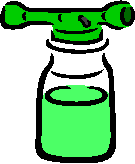 |
|
|
| |
 |
|
|
| |
Phosphorus is a nutrient required by all organisms for the basic processes of life. Phosphorus is a natural element found in rocks, soils and organic material. Phosphorus clings tightly to soil particles and is used by plants, so its concentrations in clean waters is generally very low. However, phosphorus is used extensively in fertilizer and other chemicals, so it can be found in higher concentrations in areas of human activity. Many seemingly harmless activities added together can cause phosphorus overloads.
Phosphorus exists in water in either a particulate phase or a dissolved phase. Particulate matter includes living and dead plankton, precipitates of phosphorus, phosphorus adsorbed to particulates, and amorphous phosphorus. The dissolved phase includes inorganic phosphorus and organic phosphorus. Phosphorus in natural waters is usually found in the form of phosphates (PO4-3). Phosphates can be in inorganic form (including orthophosphates and polyphosphates), or organic form (organically-bound phosphates).
Organic phosphate is phosphate that is bound to plant or animal tissue. Organic phosphates are formed primarily by biological processes. They are contributed to sewage by body waste and food residues, and also may be formed from orthophosphates in biological treatment processes or by receiving water biota. Organic phosphates may occur as a result of the breakdown of organic pesticides which contain phosphates. They may exist in solution, as loose fragments, or in the bodies of aquatic organisms.Inorganic phosphate is phosphate that is not associated with organic material. Types of inorganic phosphate include orthophosphate and polyphosphates. Orthophosphate is sometimes referred to as "reactive phosphorus." Orthophosphate is the most stable kind of phosphate, and is the form used by plants. Orthophosphate is produced by natural processes and is found in sewage. Polyphosphates (also known as metaphosphates or condensed phosphates) are strong complexing agents for some metal ions. Polyphosphates are used for treating boiler waters and in detergents. In water, polyphosphates are unstable and will eventually convert to orthophosphate.
Phosphates are not toxic to people or animals unless they are present in very high levels. Digestive problems could occur from extremely high levels of phosphate.
In freshwater lakes and rivers, phosphorus is often found to be the growth-limiting nutrient, because it occurs in the least amount relative to the needs of plants. If excessive amounts of phosphorus and nitrogen are added to the water, algae and aquatic plants can be produced in large quantities. When these algae die, bacteria decompose them, and use up oxygen. This process is called eutrophication. Dissolved oxygen concentrations can drop too low for fish to breathe, leading to fish kills. The loss of oxygen in the bottom waters can free phosphorus previously trapped in the sediments, further increasing the available phosphorus.
 There are several forms of phosphorus which can be measured. Total phosphorus
(TP) is a measure of all the forms of phosphorus, dissolved or particulate, that
are found in a sample. Soluble reactive phosphorus (SRP) is a measure of
orthophosphate, the filterable (soluble, inorganic) fraction of phosphorus, the
form directly taken up by plant cells.
There are several forms of phosphorus which can be measured. Total phosphorus
(TP) is a measure of all the forms of phosphorus, dissolved or particulate, that
are found in a sample. Soluble reactive phosphorus (SRP) is a measure of
orthophosphate, the filterable (soluble, inorganic) fraction of phosphorus, the
form directly taken up by plant cells.
Both phosphorus and orthophosphate are often measured using a colorimetric method, which means the color of treated sample reflects the concentration of the parameter. If total phosphorus is being measured, all forms of phosphorus are converted to dissolved orthophosphate with acid, persulfate, and heat. A chemical is then added to the water sample. The darker the color of the sample becomes, the more phosphorus present. This test can be done visually, comparing the treated sample to a set of reference colors. However, it is more accurate to use an electronic colorimeter, which uses a light source and a photodetector to find the concentration based on how much light is absorbed by the sample.
Factors Affecting Phosphorus Concentrations
 Wastewater and Septic System Effluent
Wastewater and Septic System Effluent
Domestic and industrial sewage are very important sources of phosphorus to surface water. Organic phosphates are formed primarily by biological processes. They are contributed to sewage by body waste and food residues. Phosphorus is essential in metabolism so is always present in animal waste. Orthophosphates and polyphosphates can be contributed by detergents, as discussed below.
Detergents
 Orthophosphates and certain polyphosphates are major constituents of many
commercial cleaning preparations. In the 1950s and 1960s, sodium phosphate was
used often as a "builder" in households detergent to increase cleaning power.
The extensive use of detergents led to major eutrophication problems, and in the
1960s efforts were made by governments, detergent manufacturers, and consumers
to reduce the use of phosphates in detergents. As a result, phosphorus
concentrations in many streams and lakes decreased. This was due to limits on
the phosphate content of detergent, and also additional treatment used in waste
water treatment plants to remove phosphorus. Many states have a ban on
phosphates in detergents.
Orthophosphates and certain polyphosphates are major constituents of many
commercial cleaning preparations. In the 1950s and 1960s, sodium phosphate was
used often as a "builder" in households detergent to increase cleaning power.
The extensive use of detergents led to major eutrophication problems, and in the
1960s efforts were made by governments, detergent manufacturers, and consumers
to reduce the use of phosphates in detergents. As a result, phosphorus
concentrations in many streams and lakes decreased. This was due to limits on
the phosphate content of detergent, and also additional treatment used in waste
water treatment plants to remove phosphorus. Many states have a ban on
phosphates in detergents.
Fertilizers
 Fertilizers generally contain phosphorus in the form of orthophosphate. Phosphate is
not very mobile in soil; it tends to remain attached to solid particles rather
than dissolving in water. However, if too much fertilizer is applied, the
phosphates are carried into surface waters with storm runoff and also with
melting snow. Soil erosion of fertilized fields and lawns can also carry a
considerable amount of particulate phosphate to streams.
Fertilizers generally contain phosphorus in the form of orthophosphate. Phosphate is
not very mobile in soil; it tends to remain attached to solid particles rather
than dissolving in water. However, if too much fertilizer is applied, the
phosphates are carried into surface waters with storm runoff and also with
melting snow. Soil erosion of fertilized fields and lawns can also carry a
considerable amount of particulate phosphate to streams.

Animal Waste
Phosphorus is essential in metabolism, so is present in animal waste. Therefore, phosphate runoff can be an issue in waters near cattle feedlots, hog farms, dairies, and barnyards.

Development/Paved Surfaces
Development can cause soil erosion, which will release phosphorus. If swamps and wetlands are drained for development, phosphorus that was buried can be exposed. During the building phase, and after everything has stabilized, phosphorus concentrations in stormwater can increase because natural filters such as trees, shrubs, and puddles have been eliminated.
Industrial Discharge
Polyphosphates are often added to water to prevent iron oxides or calcium carbonates from forming. If this water is released to streams or lakes, polyphosphates can enter the water body, and will convert to orthophosphate.
Phosphate Mining
Phosphate mining, concentrating, and processing are sources of phosphate to rivers in some areas. The most common phosphorus-containing mineral is apatite (Ca5F(PO4)3). There are no significant sources of phosphate minerals in the Boulder Creek Watershed, so this is not a problem in our area.
Drinking Water Treatment
Small amounts of orthophosphates or certain polyphosphates are added to some water supplies during treatment.

Forest Fires
Forest fires can cause soil erosion, which will release phosphorus bound to soil particles.
Synthetic Materials
Organophosphates are commonly used as construction materials, flame retardant and plasticizers.
Reduced forms of phosphorus are present in certain synthetic organic chemicals, including some that are used in insecticides.
![]() Water Quality Standards and Other Criteria Regarding
Phosphorus
Water Quality Standards and Other Criteria Regarding
Phosphorus
No national or state criteria have been established for concentrations of phosphorus compounds in water. However, to control eutrophication, the EPA makes the following recommendations: total phosphate should not exceed 0.05 mg/L (as phosphorus) in a stream at a point where it enters a lake or reservoir, and should not exceed 0.1 mg/L in streams that do not discharge directly into lakes or reservoirs (Muller and Helsel, 1999).
Phosphate levels greater than 1.0 mg/L may interfere with coagulation in water treatment plants. As a result, organic particles that harbor microorganisms may not be completely removed before distribution.
Other Information about Phosphorus
For more information on nutrients in water, see http://water.usgs.gov/nawqa/circ-1136.html.
Eutrophication
is a process that results from accumulation of nutrients in lakes or other water bodies. Eutrophication is a natural process, but can be greatly accelerated by human activities that increase the rate at which nutrients enter the water.Algae growth is limited by the available supply of phosphorus or nitrogen, so if excessive amounts of these nutrients are added to the water, algae and aquatic plants can grow in large quantities. When these algae die, they are decomposed by bacteria, which use dissolved oxygen. This process is called "eutrophication." Dissolved oxygen concentrations can drop too low for fish to breathe, leading to fish kills. Excessive amounts of algae grow into scum on the water surface, decreasing recreational value and clogging water-intake pipes. Rapid decomposition of dense algae scums with associated organisms can give rise to foul odors.
In freshwater lakes and rivers, phosphorus is often the growth limiting nutrient, because it occurs in the least amount relative to the needs of plants. In estuaries and coastal waters, nitrogen is generally the growth limiting nutrient.
"Eutrophic" waters are
characterized by high nutrient concentrations, resulting in high productivity of plant growth. Such waters are often shallow, with algal blooms and periods of oxygen deficiency. Slightly or moderately eutrophic water can support a complex web of plant and animal life. However, such waters are generally undesirable for drinking water and other needs. Waters with extreme nutrient concentrations are called "hypereutrophic.""Oligotrophic" waters are characterized by extremely low nutrient concentrations, resulting in moderate plant productivity. Oligotrophic lakes are those low in nutrient materials and consequently poor areas for the development of extensive aquatic plants and animals. Such lakes are often deep, with sandy bottoms and very limited plant growth, but with high dissolved-oxygen levels.
Some scientists have categorized trophic status according to phosphorus concentration. Lakes with phosphorus concentrations below 0.010 mg/L are classified as oligotrophic, phosphorus concentrations between 0.010 and 0.020 mg/L are indicative of mesotrophic lakes, and eutrophic lakes have phosphorus concentrations exceeding 0.020 mg/L (Muller and Helsel, 1999).